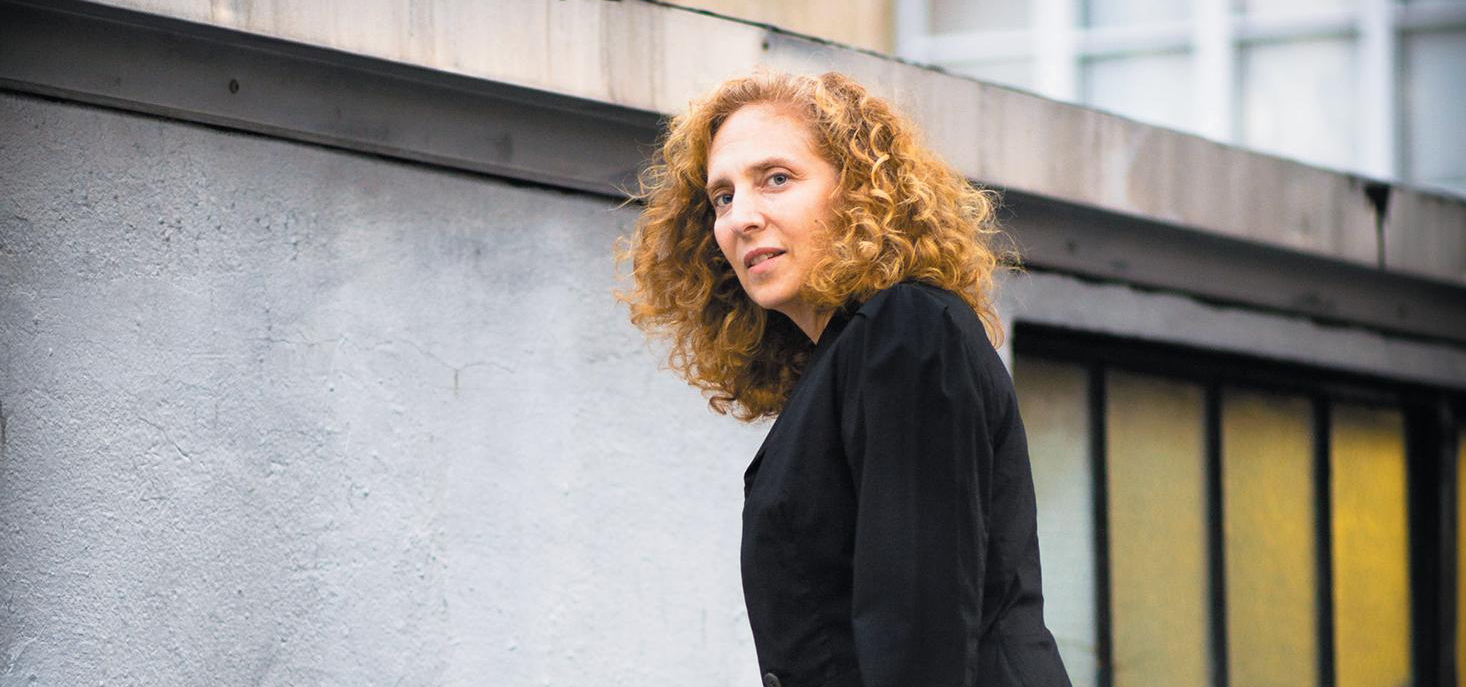Julia Wolfe: Embracing Creative Risk
Jonathan Leal on April 30, 2021
Near the end of Julia Wolfe’s Steel Hammer (2009), we enter a headbanger’s paradise: explosive percussion and strings flow into spectral choral overlays; angular rhythmic stabs align with a searing vocal trio, unfazed, belting “Nothing! Nothing! Nothing!” as if aflame onstage, backed up by Meshuggah in their prime. The phrase’s brake drums and polychords, scattered about like so much shattered glass, signal a world in which harmony is less mandate than memory, rhythm both match and fuse. It’s a minor heaven.
The phrase, a highlight among many in Wolfe’s acclaimed oratorio, feels indexical of her deft genre bending, indicative of her approach to risk. A 2016 MacArthur Fellow, professor of music composition at New York University’s Steinhardt School, co-founder and co-artistic director of the celebrated Bang on a Can All-Stars ensemble, and longtime rock ’n’ folk aficionado, Wolfe has for years glided between musical traditions, listening communities, and pop and classical registers. At times bombastic, at others hypnotic, and at still others serene, Wolfe’s music blends post-minimalist compositional techniques with experimental ensemble setups and intricate, affective arrangements to render myths, histories, and fables newly audible.
Recent projects — including Flower Power (2020), a riffy, hallucinatory rendering of the “Make Love, Not War” concepts of the long ’60s, and Anthracite Fields (2014), a wide-ranging work focused on Pennsylvania’s coal-mining histories (for which she won the 2015 Pulitzer Prize in Music) — have involved Wolfe and her collaborators studying American countercultural, industrial, and labor histories and exploring the possibilities of music as narrative, or narrative as music — or, more directly: facts, feelings, and the ways we frame them. And where her Steel Hammer was, in 2010, a Pulitzer finalist, soon it will be released as a feature-length film.
On May 6, 2021, Cal Performances will debut the new film adaptation of Wolfe’s Steel Hammer, her long-form composition based on hundreds of variants of the John Henry ballads, via its Cal Performances at Home virtual series. The film project features performances by Bang on a Can All-Stars and a new vocal trio (Molly Netter, Rebecca Hargrove, and Sonya Headlam), as well as the creative contributions of filmmaker Jeremy Robins, conductor and music director David Bloom, and percussionist-producer David Cossin.
Recently, Wolfe spoke with SFCV about how she and her team created the film amid the COVID-19 pandemic. She also reflected on how she’s thought about music, language, narrative, collaboration, and renewed connection over the last year.
(Our conversation has been lightly edited and condensed here for clarity.)
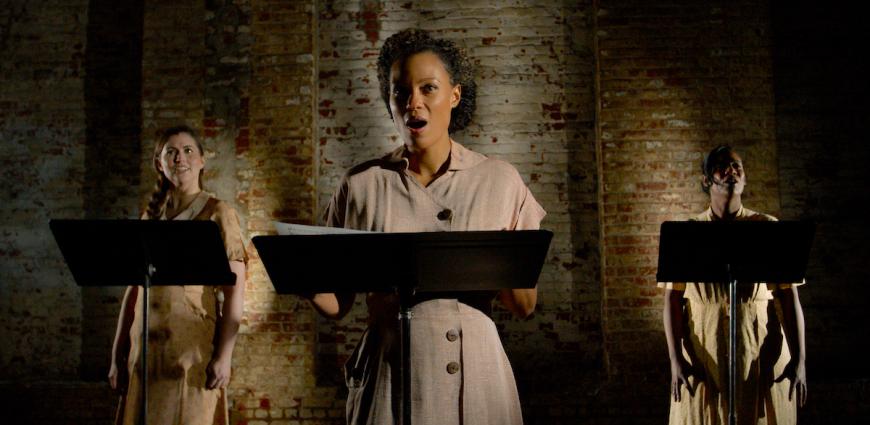
How did this film adaptation of Steel Hammer happen amid the COVID-19 pandemic?
Before the idea for a film came up, and before the pandemic started, we actually had an in-person gig scheduled in Berkeley with Cal Performances. And when everything shut down, we figured, “Well, that’s that.” But before long, Cal Performances called us and asked, “Can you guys do a performance? We’ll film it and present it.” We wondered: Would that even be possible? Our group [the All Stars] spread out all over the place — Ken Thompson was in Berlin, and Arlen Hlusko, the cellist, was in Canada. And we weren’t about to travel to be in the same room together, so we really didn’t think it’d be possible. But the more we thought about it, considered it, the more excited we became about figuring out how to make it happen and reimagine the piece. And what we ended up doing was recording new audio in different locations, creating a visual dimension, and then bringing it all together.
How did that work?
Musically, Ken [clarinets] recorded in Berlin; Mark Stewart [electric guitar] laid down some tracks in his barn in northwestern Massachusetts. Plus, we still had the stems, or the individual audio tracks from the original Steel Hammer recording sessions, and we were able to use some of those and re-mix the whole piece, adding in the new players who weren’t present on the original recording, including this new, incredible vocal trio: Molly Netter, Rebecca Hargrove, and Sonya Headlam.
Once we had all the new parts recorded, we started assembling. Eventually, we put a click track to what we created, and then we went into the studio — probably one of the first times I was really with musicians again. It was very recent, just some weeks ago. We went into the studio in Williamsburg, Brooklyn. We all wore masks, many of us were fully vaccinated, and we all took COVID tests before meeting. The three singers went into their own separate little booths. And we could all still see each other, as well as conductor and music director David Bloom, thanks to some transparent partitions.
Also, David Cossin, one of the percussionists in the ensemble, is also a producer, and he took on the role of producing these recordings. It’s amazing that this was possible, that we could come together in this way.
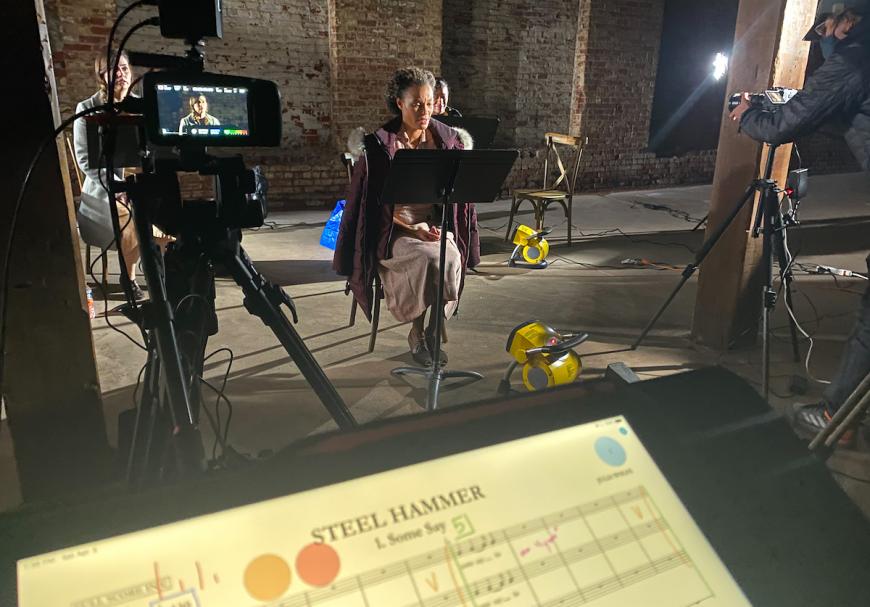
Amazing, too, that because of the circumstances, you all had these moments of local musical intimacy, recording in those booths, while also blending with these cross-continental, trans-oceanic recording sessions.
It was incredible, yeah. When I hear Ken’s clarinet mixed in, it just sounds so natural. It’s just got this crazy raw sound that only Ken has. It’s so nice he was part of the recording even though we were not physically near one another. That’s the studio magic that David and the engineers brought.
Recording amid the pandemic, revisiting the piece so intensely for this new film project — did that change your relationship to Steel Hammer? If so, how?
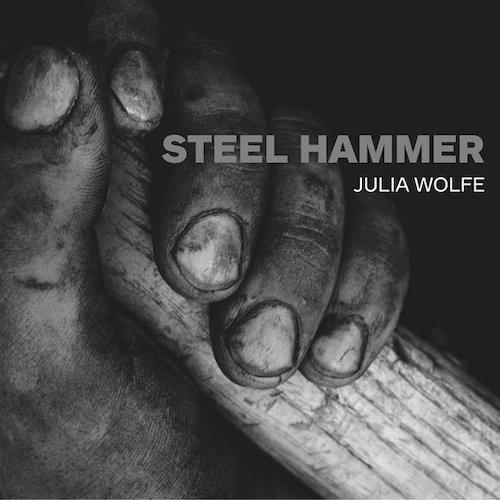
It did. Steel Hammer has had this interesting life over the years and revisiting it in each instance has been so interesting. The original version was actually written for Trio Mediaeval, wonderful singers often singing medieval music while also involved in their own folk traditions in Norway. Then we did a theatrical version of Steel Hammer with director Anne Bogart [and the SITI Theater Company, for Brooklyn Academy of Music’s 2015 Next Wave Festival], which featured actors and text layered in between movements. And with this new film version, we have a different group of singers and a more “American” sound, which led us to wonder: “What is the performance practice of singing this piece?” Revisiting and revising the work for these different occasions has been so interesting, and I feel with this most recent version, I reacquainted myself with the piece in a way that almost made me forget that I wrote it.
That’s wonderful. And that experience of becoming reintroduced to your own piece — that seems unexpectedly resonant with the resensitization many have felt during the pandemic. Staying near home, noticing new details, paying more intense attention, becoming newly acquainted with local nuances.
Yeah, I like that. I think some people have felt that about nature especially. For instance, I’ve never watched spring the way I watched spring this past year — the gradual blossoming of trees, all these bird sightings in Central Park — that one snowy owl appearing. It’s true, this idea of paying closer attention to your surroundings, whether inside or outside. There’s something there.
One of the many things that strikes me about Steel Hammer is its narrative backbone. As a composer, how have you thought about balancing sound and story?
Well, storytelling has always been there for me. My early background was in music, theater, and creative writing, and working with words actually came first. Then, when I started with music, I was amazed it was possible to do this expressive thing with sounds and not words — to try to express something almost inexpressible. I’ve always found that so fascinating, that sound can help us say things we can’t yet articulate with language.
Once I learned this, I avoided words for a long time. I also avoided narrative, in a way, even though it’s been there in my work regardless. But when I got to my piece Cruel Sister (2004), which was for string orchestra and followed the arc of a ballad, things changed, and I started taking steps toward thinking directly about music and narrative together.
And when I started Steel Hammer, I felt I needed to return to text, to find a way of relaying history through music. It all began with text and early sound sketches, and then I did a lot of research and gathering — comparing versions of the John Henry ballad, sifting through conflicting facts. Text drives the music for the most part, but the result is not really narrative in the same way that theater and opera productions can be, with traditional characters and people singing to one another, and so on. Steel Hammer is more abstract than that, and also more literal: for instance, when the singers sing about John Henry’s hammer, a percussionist hits a brake drum really hard right after the word “hammer.” Embracing those obvious, literal connections was so much fun.
That’s fascinating. And exploring that literality also seems like a way of continuing to explore what you mentioned before — that idea of music sitting at the edge of linguistic expression, or what the literary scholar Brent Hayes Edwards has called the “limits of articulacy.” Those literal connections between “hammer” and the sound of the brake drum encourage someone to sit with the relationships between words and sounds.
Right, exactly.
Listening to a movement from Steel Hammer like “The States,” I’m captivated by the way your explorations of sounds and words plays out through that “post-minimalist” gesture of repeating U.S. state names. What I hear in there, personally, is a meditation on the fragments and details you’re sitting with.
I think meditation is a really great word for that, actually. Listening to the musicality of state names — “Georgia, Georgia, Georgia”; “Alabama, Alabama, Alabama.” They all have these syllables and rhythms and associations. There’s so much to work with. When you dwell on a word and start to sing it again and again, the meanings can intensify, or sometimes even get lost. Repetition blurs those boundaries.
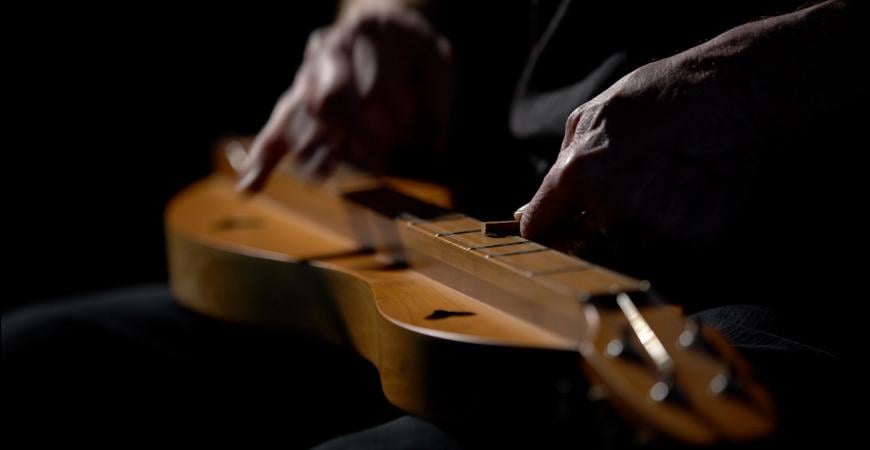
Absolutely. Going back to narrative for a moment — Steel Hammer, as you mentioned, also involves these important ethnographic and political dimensions. Can you tell me a bit about what got you interested in researching those broader themes the piece engages, especially labor history?
You know, I’ve always been interested in political and social issues. Power, protest, capitalism, workers, labor — those threads have been part of my life since I was pretty young. And so when I began Steel Hammer, I didn’t say to myself, “I’m going to sit and write a political piece.” It was more that I wanted to explore interests I’d had for a very long time, some of which had come through in the titles of older works — Arsenal of Democracy, Window of Vulnerability, terms used in military conflict. Thinking about things like anonymized labor and the relationships between individuals and groups has been important to me since I was in college, and learning from composers like Martin Bresnick, Louis Andriessen, and others who were very highly political helped me extend that through sounds and ensembles.
Speaking of sounds — sonically, so much of your work seems completely unafraid of experimentation. How do you approach compositional risk?
I’m always looking for some unknown territory. I never want to sit still. Sometimes, a piece really is a leap in a new direction; other times, it’s more a refining of where you’ve been. Both are valid and important; I don’t think the “new” in itself is necessarily “the thing.” What’s more important is having a sense that you’re always reaching for something.
This plays out in Steel Hammer especially with Bang on a Can All-Stars, because the piece is written for who they are specifically, for their unique musicianship. Mark Stewart, for example, is a clogger who plays the banjo, and his specific musicianship played an important part in what I could access for this piece. The crazy sounds Robert Black makes from the bass, too — so much of the piece’s sound is inspired by the group; the qualities of the specific sounds that they can make. So in terms of taking risks, I think I just always try to find something new or go some places I haven’t been before, and when I get to write for these guys, because they’re so talented and so game, I feel particularly liberated.
As you mentioned earlier, Steel Hammer has had a lot of lives across media and formats — the musical piece, the theatrical production, and now the film adaptation. What has it been like for you working across media as a composer?
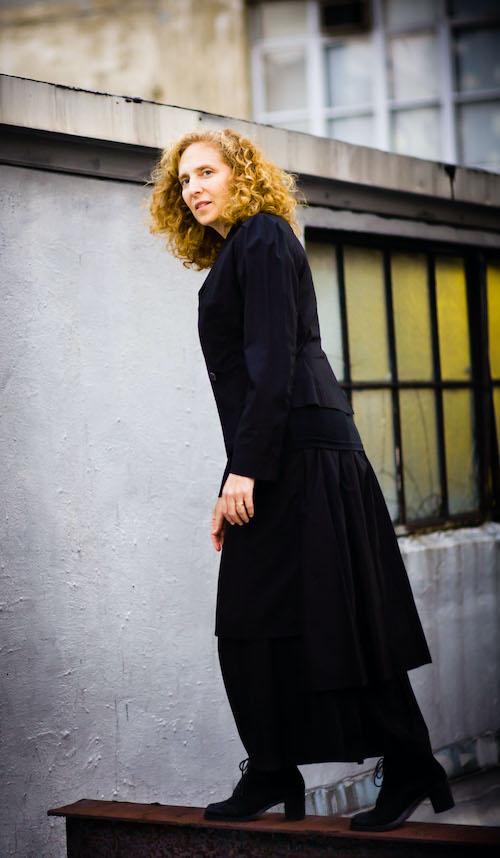
That’s a good question. This film is so different from what I’ve done before. For this project, I’ve been working with the team on building the sound, but in terms of the visual layer, filmmaker Jeremy Robins has been pretty independent. We’ve had a very open back-and-forth dialogue since the beginning about the sensibility of the piece, but in a way, he’s really on his own.
One of the things we’ve talked about a lot is how he’s filming the performers. He actually traveled to all of their locations — all except Germany, as he had a friend there who helped him with some filming — and he introduced this visual concept where the players would be in black against a black background, so you’d see their hands in relief and focus on the mechanics of them playing their instruments. It’s very much his aesthetic, his take on how to integrate these performers and their different locations. What he’s done with the singers is also really amazing — they filmed in this huge, cavernous old factory in New Jersey, with huge metal doors and a wall made of rock. It’s intense.
Jeremy’s also interspersing archival footage, which is really beautiful, as that’s sort of what the piece is about — piecing together these little bits of history. At some points, he has the singers on screen, then he cuts to train tracks, then he cuts to bits of archival footage he’s received permission to use. There’s also some great animation.
That’s fantastic.
Yeah, it really is. The whole project is now so far beyond a filmed performance. I’ve really appreciated collaborating with so many artists for it — artists who are all experts in their fields. I have lots of opinions about the overall artistic direction, but I love it when collaborators bring their vision. And everyone involved with this film has put so much into it. We’re excited to share the work.
Go Beyond the Stage with behind-the-scenes artist talks and interviews, lectures and public forums with UC Berkeley faculty, recommended reading, and other interesting connections to the Cal Performances At Home programs.
Share This!
2022/23 Season
Explore the full season and celebrate the power of the performing arts to inspire, uplift, comfort, and delight.
Now, more than ever, we need your help
Invest in the future of artists and the vital role of the live performing arts by making a gift to Cal Performances today.



